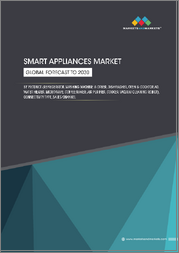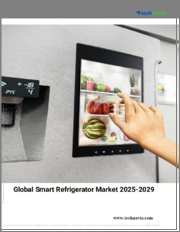
|
시장보고서
상품코드
1536977
세계 스마트 냉장고 시장 - 점유율 분석, 산업 동향, 통계, 성장 예측(2024-2029년)Smart Fridge - Market Share Analysis, Industry Trends & Statistics, Growth Forecasts (2024 - 2029) |
||||||
스마트 냉장고 시장 규모는 2024년 64억 3,000만 달러로 추정되며, 2029년 98억 3,000만 달러에 이를 것으로 예측되며, 예측 기간 중(2024-2029년) CAGR은 8.87%로 성장할 전망입니다.

기술의 진보는 가전제품의 몇 가지 개선으로 이어졌고, 그것은 스마트 냉장고의 출시로 이어졌습니다. 스마트 냉장고는 음성인식, 터치스크린, 인터넷, 블루투스 연결 등의 고급 기능을 통합하여 소비자에게 편의성을 제공하기 위한 것입니다. 휴대전화나 태블릿 기기와 같은 개인 기기는 스마트 냉장고에 쉽게 연결할 수 있습니다. 사용자는 무선 개인 장치를 통해 소프트웨어를 통해 냉장고 내의 식품 저장을 쉽게 처리하고 조정할 수 있습니다. 따라서 디지털화의 진전이 스마트 냉장고 시장의 성장으로 이어졌습니다.
COVID-19 팬데믹의 초기 단계에서는 공급망의 혼란에 의한 제조·유통 서비스의 정지로 시장은 손실을 입었습니다. 그 후, 문 닫기나 재택 근무 문화에 의해 스마트 냉장고 수요가 증가했습니다. 유행이 지나가면서 시장은 계절적 수요 변동에 따라 완만하게 성장하고 있습니다.
주택건축 증가와 그린빌딩의 출현으로 스마트 냉장고 수요가 높아졌습니다. 또한 라이프 스타일의 변화와 꽉 일정에 따라 스마트 냉장고에 대한 요구가 높아지고 있습니다.
스마트 냉장고 시장 동향
스마트 홈과의 통합
스마트 냉장고는 스마트 홈 에코시스템과 협력할 수 있도록 설계되었습니다. 스마트 서모스탯과 같은 다른 연결 장비와 상호 작용하여 에너지 효율을 최적화하고 이상적인 온도를 유지할 수 있습니다. 또한 조명 시스템과의 통합을 통해 사용자는 냉장고의 내용에 따라 주방 조명을 조정할 수 있습니다. 이 냉장고에는 Amazon Alexa와 Google Assistant와 같은 음성 어시스턴트도 탑재할 수 있습니다. 이러한 기능은 사용자 경험을 향상시키고 효율적인 삶을 이끌어 냅니다.
북미가 시장을 독점
북미에서는 핵가족이 증가하고 있으며, 더 나은 지침을 제공하고 운영 시간을 단축하는 스마트 냉장고와 같은 고급 가전제품에 대한 요구가 커지고 있습니다. 대부분의 스마트 냉장고는 고급 제품으로 간주됩니다. 이 지역에는 고소득자층이 존재하고 가전제품에 대한 소비지출이 증가하고 있는 것이 북미 시장의 성장을 뒷받침하고 있습니다.
스마트 냉장고는 스마트폰에 연결하여 멀리 떨어진 곳에서 작동할 수 있으므로 북미에서 높은 수요가 있습니다. 북미 제조업체는 전력 사용을 제한하고 에너지 절약에 도움이 되는 센서와 기능을 갖춘 스마트 냉장고를 제조합니다.
스마트 냉장고 산업 개요
스마트 냉장고 시장은 단편화되었습니다. 시장 점유율 측면에서 현재 여러 회사의 대기업이 시장을 독점하고 있습니다. 그러나 수요는 소비자의 소득에 달려 있습니다. 대기업은 대량 구매, 제품 라인업, 효과적인 상품화 계획 및 마케팅에서 경쟁하고 있습니다. 소규모 기업은 시장 부문에 초점을 맞추고 제품의 강점과 우수한 고객 서비스로 경쟁합니다. 이 시장 주요 기업은 다음과 같습니다. Electrolux Group, Haier Group Corporation, Whirlpool Corporation, Samsung Electronics, and Panasonic Corporation.
기타 혜택:
- 엑셀 형식 시장 예측(ME) 시트
- 3개월간의 애널리스트·지원
목차
제1장 서론
- 조사의 전제조건과 시장 정의
- 조사 범위
제2장 조사 방법
제3장 주요 요약
제4장 시장 인사이트과 역학
- 시장 개요
- 시장 성장 촉진요인
- 기술에 정통한 밀레니얼 세대의 인구 증가
- 구매력 향상과 가처분 소득 증가
- 시장 성장 억제요인
- 악성코드 공격의 위험
- 유지 보수 비용 증가
- 시장 기회
- 스마트 냉장고의 기술 진보
- 밸류체인 분석
- 업계의 매력도 - Porter's Five Forces 분석
- 공급기업의 협상력
- 구매자의 협상력
- 신규 진입업자의 위협
- 대체품의 위협
- 경쟁 기업간 경쟁 관계
- 스마트 냉장고 시장의 최근 동향에 대한 통찰
- 업계의 기술 혁신에 대한 통찰
- COVID-19가 시장에 미치는 영향
제5장 시장 세분화
- 유형별
- 사이드 바이 사이드 냉장고
- 하단 냉장고 냉장고
- 더블 도어 냉장고
- 싱글 도어 냉장고
- 프렌치 도어 냉장고
- 유통 채널별
- 온라인
- 오프라인
- 최종 사용자별
- 주택용
- 상업용
- 지역별
- 북미
- 미국
- 캐나다
- 멕시코
- 기타 북미
- 유럽
- 영국
- 독일
- 이탈리아
- 기타 유럽
- 아시아태평양
- 인도
- 중국
- 일본
- 호주
- 기타 아시아태평양
- 남미
- 브라질
- 아르헨티나
- 기타 남미
- 중동 및 아프리카
- 남아프리카
- 아랍에미리트(UAE)
- 기타 중동 및 아프리카
- 북미
제6장 경쟁 구도
- 시장 집중도 개요
- 기업 프로파일
- Electrolux Group
- Haier Group Corporation
- Whirlpool Corporation
- Samsung Electronics Co. Ltd
- Bosch
- Midea Group
- Panasonic Corporation
- Hitachi
- Frigidaire
- Liebherr Group
제7장 시장 동향
제8장 면책사항과 출판사에 대해서
JHS 24.08.29The Smart Fridge Market size is estimated at USD 6.43 billion in 2024, and is expected to reach USD 9.83 billion by 2029, growing at a CAGR of 8.87% during the forecast period (2024-2029).

Technological advancements led to several improvements in home appliances, which led to the launch of the smart fridge. Smart fridges are integrated with advanced features like voice recognition, touch screens, internet, and Bluetooth connectivity that aim to provide convenience to consumers. Personal devices like cell phones and tablets can easily connect to smart fridges. Users can easily handle and regulate food storage in the refrigerator through wireless personal devices via software. Therefore, the rise in digitalization led to the growth of the smart fridge market.
During the initial stage of the COVID-19 pandemic, the market experienced losses due to a stoppage in manufacturing and distribution services due to supply chain disruptions. Later, due to lockdowns and the work-from-home culture, the demand for smart fridges increased. With the passing of the pandemic, the market is experiencing gradual growth according to seasonal demand fluctuations.
The rise in residential constructions and the emergence of green buildings led to a high demand for smart fridges. Also, lifestyle changes and tight schedules increased the requirement for a smart fridge.
Smart Fridge Market Trends
Integration With Smart Homes
Smart fridges are designed in such a way that they can collaborate with the smart home ecosystem. They can interact with other connected devices, such as smart thermostats, to optimize energy efficiency and maintain ideal temperatures. Also, integration with lighting systems enables users to adjust kitchen lighting based on fridge contents. These fridges can also have voice-activated assistants such as Amazon Alexa or Google Assistant. These features enhance the experience of users and lead to efficient living.
North America Dominates the Market
The rising number of nuclear families in North America is increasing the need for advanced appliances like smart fridges, which offer better guidance and save time in operation. Most smart fridges are considered premium products. The presence of high-income groups in the region and the increasing consumer spending on electronics drives the market's growth in North America.
Smart fridges are in high demand in North America because they can be connected to smartphones and operated from distant locations. Manufacturers in North America have made smart fridges with sensors and features that limit electricity usage and help energy conservation.
Smart Fridge Industry Overview
The smart fridge market is fragmented. In terms of market share, a few of the major players currently dominate the market. However, demand is driven by consumer income. Large companies compete through volume purchasing, product range, and effective merchandising and marketing. Small companies focus on a market segment and compete through the strength of their products and superior customer service. Some of the major players in this market are Electrolux Group, Haier Group Corporation, Whirlpool Corporation, Samsung Electronics Co. Ltd, and Panasonic Corporation.
Additional Benefits:
- The market estimate (ME) sheet in Excel format
- 3 months of analyst support
TABLE OF CONTENTS
1 INTRODUCTION
- 1.1 Study Assumptions and Market Definition
- 1.2 Scope of the Study
2 RESEARCH METHODOLOGY
3 EXECUTIVE SUMMARY
4 MARKET INSIGHTS AND DYNAMICS
- 4.1 Market Overview
- 4.2 Market Drivers
- 4.2.1 Growth in the Tech-Savvy Millennial Population
- 4.2.2 Increasing Purchasing Power and Rising Disposable Incomes
- 4.3 Market Restraints
- 4.3.1 Risk of Malware Attacks
- 4.3.2 Higher Cost of Maintenance
- 4.3.3 Market Opportunities
- 4.3.3.1 Technological Advancements in Smart Fridges
- 4.4 Value Chain Analysis
- 4.5 Industry Attractiveness - Porter's Five Forces Analysis
- 4.5.1 Bargaining Power of Suppliers
- 4.5.2 Bargaining Power of Buyers
- 4.5.3 Threat of New Entrants
- 4.5.4 Threat of Substitutes
- 4.5.5 Intensity of Competitive Rivalry
- 4.6 Insights on Recent Developments in the Smart Fridge Market
- 4.7 Insights on Technological Innovations in the Industry
- 4.8 Impact of COVID-19 on the Market
5 MARKET SEGMENTATION
- 5.1 By Type
- 5.1.1 Side-by-side Refrigerators
- 5.1.2 Bottom Freezer Refrigerators
- 5.1.3 Double Door Refrigerators
- 5.1.4 Single Door Refrigerators
- 5.1.5 French Door Refrigerators
- 5.2 By Distribution Channel
- 5.2.1 Online Stores
- 5.2.2 Offline Stores
- 5.3 By End User
- 5.3.1 Residential
- 5.3.2 Commercial
- 5.4 By Geography
- 5.4.1 North America
- 5.4.1.1 United States
- 5.4.1.2 Canada
- 5.4.1.3 Mexico
- 5.4.1.4 Rest of North America
- 5.4.2 Europe
- 5.4.2.1 United Kingdom
- 5.4.2.2 Germany
- 5.4.2.3 Italy
- 5.4.2.4 Rest of Europe
- 5.4.3 Asia-Pacific
- 5.4.3.1 India
- 5.4.3.2 China
- 5.4.3.3 Japan
- 5.4.3.4 Australia
- 5.4.3.5 Rest of Asia-Pacific
- 5.4.4 South America
- 5.4.4.1 Brazil
- 5.4.4.2 Argentina
- 5.4.4.3 Rest of South America
- 5.4.5 Middle East and Africa
- 5.4.5.1 South Africa
- 5.4.5.2 UAE
- 5.4.5.3 Rest of Middle East and Africa
- 5.4.1 North America
6 COMPETITIVE LANDSCAPE
- 6.1 Market Concentration Overview
- 6.2 Company Profiles
- 6.2.1 Electrolux Group
- 6.2.2 Haier Group Corporation
- 6.2.3 Whirlpool Corporation
- 6.2.4 Samsung Electronics Co. Ltd
- 6.2.5 Bosch
- 6.2.6 Midea Group
- 6.2.7 Panasonic Corporation
- 6.2.8 Hitachi
- 6.2.9 Frigidaire
- 6.2.10 Liebherr Group*



















